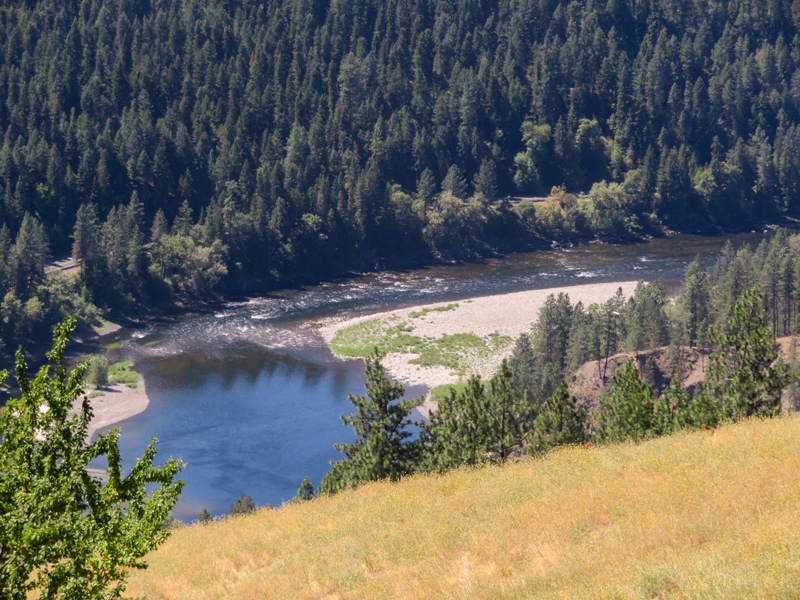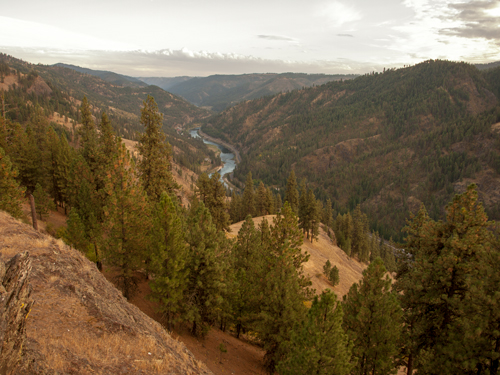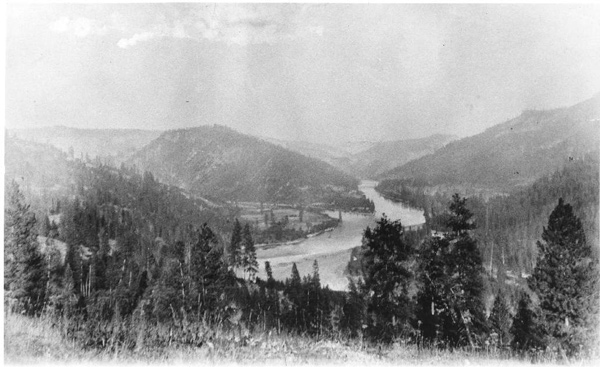Twisted Hair’s Fishing Island
The Nez Perce canoeists whom Clark admired poled their dugouts upriver through rapids such as this, which is in the Clearwater opposite Chief Twisted Hair‘s Fishing Island, present China Island. This one was probably much more challenging, and stretched all the way across the riverbed, before the 1860s, when the worst spots were cleared out to facilitate sternwheel steamboat traffic. Directly under the near shore is the roadbed of the Northern Pacific’s Clearwater Short Line, completed in 1899 to connect Lewiston, Idaho, with Kooskia, a distance of 74 miles.[1]Borg Hendrickson and Linwood Laughy, Clearwater Country! The Traveler’s Historical & Recreational Guide, Lewiston, Idaho—Missoula, Montana (Kooskia, Idaho: Mountain Meadow Press, 1989), … Continue reading
On 21 September 1805 Clark arrived at “Fishing Island”[2]Later named China Island, it no longer exists. James R. Fazio, Across the Snowy Ranges: the Lewis and Clark Expedition in Idaho and Western Montana (Moscow, Idaho: Woodland Press, 2001), 102. where he met Chief Twisted Hair. On the twenty-second he retraced his steps to Twisted Hair’s Weippe Prairie camp, then rejoined Lewis and the rest of the party at the eastern prairie camp. They all spent the twenty-third up on the Prairie, and on the next day descended into Clearwater Canyon to the campsite at Fishing Island. The twenty-fourth was a tough day for the expedition. So sick was Lewis that he was, said Clark, “Scercely able to ride on a jentle horse which was furnished by the Chief.” Some of the men were similarly “So unwell that they were Compelled to lie on the Side of the road for Some time others obliged to be put on horses.” For that reason most of the party stayed put on the twenty-fifth, while Clark and the Chief scouted out trees suitable for canoes, which they found only a short distance away, opposite the mouth of the “Cho-pun-nish River.” On 26 September 1805 they all “Set out early and proceeded down the river to the bottom on the S Side opposit the forks formed a Camp.”
Rendezvous with Lewis
Clearwater River Canyon
View east
© 19 September 2009 by Kristopher K. Townsend. Permission to use granted under the Creative Commons Attribution-Share Alike 4.0 International license.
Clark spent the night of the twenty-first at Twisted Hair’s camp on an island in the Middle Fork of the Clearwater River. The next morning the chief and his son accompanied him back up to the village on Weippe Prairie where he expected to rendezvous with Lewis. Clark rode a young horse which, “in fright threw himself & me 3 times on the side of a Steep hill & hurt my hip much.” They arrived at sunset to find Captain Lewis and his party “much fatigues, & hungery, much rejoiced to find something to eate of which They appeared to partake plentifully.” Well aware of the hazard of overtaxing a starved digestive system, noted Clark, “I cautioned them of the consequences of eateing too much &c.” He admitted that he himself had overdone it: “I find myself verry unwell all the evening from eateing the fish & roots too freely.” Venison was what they all needed, but the hunters, though they had signs of deer, returned empty-handed. “Those Indians Stole out of R. F. [Reubin Field] Shot pouch his knife[,] wipers[3]Pieces of cloth to be attached to a ramrod and used to clean the interior of the barrel, essential for the proper maintenance of any firearm. Compas & Steel, which we Could not precure from them.”
Twisted Hair’s Advice
September 22 was a good day for Clark. His Nez Perce host was clearly proud of his country, and eager to share his knowledge of it with these visitors from the East:
I got the Twisted hare to draw the river from his Camp down which he did with great cherfullness on a white Elk Skin, from the 1s fork which is a few seven miles below, to the large fork on which the So So ne or Snake Indians fish, is South 2 Sleeps; to a large river [Columbia River] which falls in on the N W. Side and into which The Clarks river [the Bitterroot-Clark Fork system] empties itself is 5 Sleeps from the mouth of that river to the falls is 5 Sleeps. . . . one other Indian gave me a like account of the Countrey.[4]The first fork is the North Fork of the Clearwater River, which Clark called Chopunnish. The “large fork” was the Snake River, which Clark had named for Lewis nearly two months before, … Continue reading
This proved to be among the most reliable travel advice he had received on the entire journey to date. (A Nez Perce man they encountered at Travelers’ Rest told the captains it would take only five sleeps, or six days, to cross the Bitterroots, but it took eleven sleeps to reach a suitable place to carve canoes, and once there it took a whole day to recover from the experience before they could begin work.) They would leave Canoe Camp on 7 October 1805 and arrive at the Snake River on the tenth. Since they spent the ninth repairing a canoe and drying out soaked supplies, it actually took them three travel days—two sleeps. Clark estimated the distance at 60 miles. (It is approximately 45 riverside-highway miles today.) They would leave the mouth of the Clearwater on 11 October 1805 and arrive at the Columbia on the sixteenth, which totals six days, or 5 sleeps. Clark’s estimate was 140 miles; it is closer to 136 miles today. Leaving the mouth of the Snake on he 17th, they were to arrive at the Great Falls of the Columbia (Celilo Falls) six days—five sleeps—later, on 22 October 1805.
Finding Canoe Camp
Ahsahka Village, c. 1890
North and Middle Forks Clearwater River
Courtesy Nez Perce National Historic Trail, National Park Service, NEPE-HI-1637.
The North Fork enters the Clearwater River from the left near the center of this photo. The Ahsahka Village was located on the northern (far) shore of the Clearwater, and Lewis and Clark’s Canoe Camp was across the river, the near shore in this photo.
On the morning of 25 September 1805, which was to become “a verry hot day,” Clark, Twisted Hair, and two young men set out early from Fishing Island—which Ordway had called “a small prarie Island”—to find some trees large enough to make dugout canoes from. “I was furnished with a horse,” wrote the captain, “and we proceeded on down the river.”
Within a mile they “Crossed a Creek . . . from the right verry rockey which I call rock dam Creek & Passed down on the N side of the river to a fork from the North,” which he named “Cho-pun-nish River.” While they rested there, one of the young Indians gigged six fine salmon—”two of them were roasted and we eate.” About that time two families, in dugout canoes that were “long Stedy and without much rake,” came up the river with their furniture and provisions. Clark crossed the river on his horse and set out up the south side through a “narrow Pine bottom” that contained some promising trees. One of the Indian canoes manned by two Indians with poles left the forks at the same time, and arrived at Fishing Island within fifteen minutes notwithstanding 3 rapids which they had to draw the Canoe thro’ in the distance.”
Lewiston, Idaho, was founded in 1861 as a trade, service, and communications center for the many gold prospectors who rushed to file claims at the western fringe of the Bitterroot Mountains, such as Pierce (north of Weippe Prairie) and Elk City (south of Kooskia [pron. KOOS-kee]). To meet the need of the fast-growing settlement for building materials, a logger named Jim Ford chose this drainage—”a fine Pine Country,” Clark noticed—as a center of operations, cutting trees and floating the logs down the Clearwater to Lewiston.
The name “Village Creek,” which Clark assigned to this drainage, implies that Twisted Hair’s canyon home was here. However, Clark place a symbol for an Indian village several miles up the Clearwater, at the mouth of a stream that didn’t actually exist.
Notes
| ↑1 | Borg Hendrickson and Linwood Laughy, Clearwater Country! The Traveler’s Historical & Recreational Guide, Lewiston, Idaho—Missoula, Montana (Kooskia, Idaho: Mountain Meadow Press, 1989), 21-22, 42-43. |
|---|---|
| ↑2 | Later named China Island, it no longer exists. James R. Fazio, Across the Snowy Ranges: the Lewis and Clark Expedition in Idaho and Western Montana (Moscow, Idaho: Woodland Press, 2001), 102. |
| ↑3 | Pieces of cloth to be attached to a ramrod and used to clean the interior of the barrel, essential for the proper maintenance of any firearm. |
| ↑4 | The first fork is the North Fork of the Clearwater River, which Clark called Chopunnish. The “large fork” was the Snake River, which Clark had named for Lewis nearly two months before, when they were among the Lemhi Shoshones. The “large river” was the Columbia. “The Clarks river” was the present Bitterroot-Clark Fork system, which he had named by the time he reached Travelers’ Rest. By extrapolating from his personal observations during six weeks of travel, combined with Indian information conveyed to him across a gaping language barrier, he had constructed a remarkably accurate mental picture of the geography of the Northern Rockies from the 45th to the 49th parallel. |



